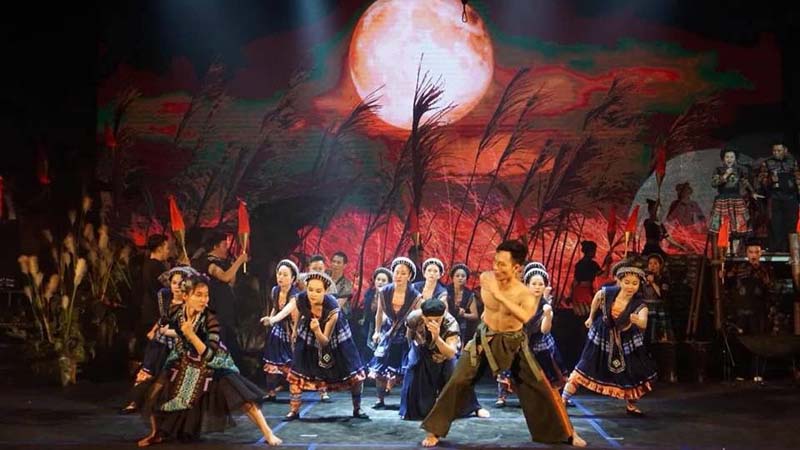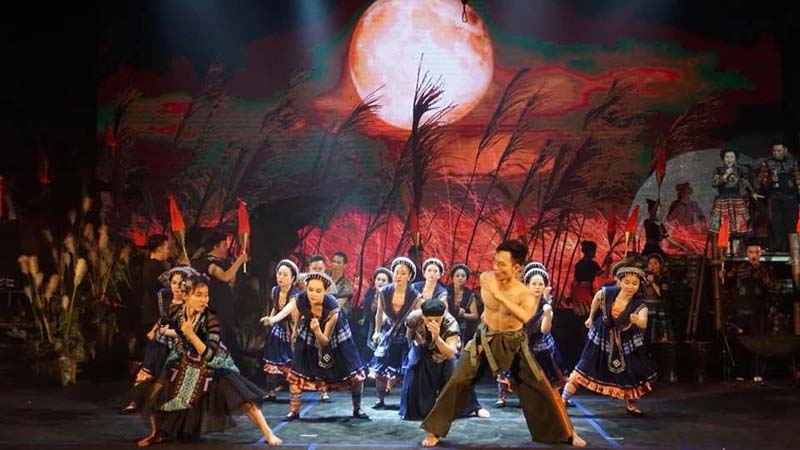
Featuring a rich blend of the H’Mong ethnic culture, the recent performance of the ‘My’ theatre play at Hanoi Opera House left a deep impression on the Hanoi audience as the artists brought traditional H’Mong musical instruments to the stage and used daily utensils as props for the screen production.

Costumes
in ‘My’ play honour the arts of brocade and decorative patterns of the H’Mong
people
Inspired by‘Vo Chong A Phu’(A Phu Couple), a short story by
writer To Hoai, the artists from the Viet Bac Theatre for Traditional Folk
Music and Dance reinterpreted the literary work into the languages of singing
and dancing. The 12-act play is choreographed, scripted and directed by Tuyet
Minh.
Instead of reproducing the life tragedy of My, the main
character of the short story, as in the original, the stage version highlights
the unique culture of the H’mong ethnic community through a romantic love market,
folk games, and the people’s daily activities, such as the making of corn wine,
weaving, and fabric dyeing. The play also contributed a voice against out-dated
customs, including wife robbery and drug use.
According to Tuyet Minh, from the beginning, she decided
to feature live music for the stage instead of electronic music. Minh and her
team spent days searching for H’Mong artisans and convinced them to provide
instructions for the troupe members on how to play the traditional H’Mong
musical instruments. It took the troupe five months to practice and play the
instruments well in a harmony.
Four songs performed during the play are presented in an
acapella style, leaving an emotional impression on the theatre goers.
In addition, ‘My’ is appreciated by the audience and arts
critics thanks to the costume designs, with designer Hoang Tung paid great
attention to honouring the arts of brocade and decorative patterns of the
H’Mong people.
Thanks to their due investment, the play won two gold and
three silver medals at the National Song and Dance Festival. It was named the
Most Impressive Programme, and Tuyet Minh was awarded the Best Choreographer of
the festival.
The play was made by order of the Ministry of Culture,
Sports and Tourism at a total investment of VND3 billion, which was made with
the aim to earn medals and was also designed as a cultural product for tourists
to the Hanoi Oprea House.
The play has been adjusted and cut into a 30-minute
performance to make it fit the tour’s schedule. Accordingly, the singing has
been reduced while dancing and folk music are spotlighted on the stage. The
troupe members are divided into two teams to keep the show’s continuity.
‘My’ is available at the Hanoi Opera House from
Mid-August and there will be three shows a week in order to diversity
high-quality arts products for visitors to the Hanoi Opera House.
Source: NDO
With an increasingly vibrant and widespread emulation movement aimed at building cultured residential areas and cultured families, Yen Thuy District has been making steady progress toward improving both the material and spiritual well-being of its people, while fostering a civilized, prosperous, beautiful, and progressive community.
Once lacking recreational spaces and community facilities, Residential Group 2 in Quynh Lam Ward (Hoa Binh City) has recently received attention for the construction of a new, spacious, and fully equipped cultural house. The project followed the model of state support combined with public contributions in both labor and funding.
The "All people unite to build cultural life" movement, which has been effectively integrated with Kim Boi district’s socio-economic development goals, is fostering a lively spirit of emulation across local residential areas, hamlets, villages, public agencies, and enterprises. In addition, through the initiative, traditional cultural values are being preserved and promoted, while community solidarity and mutual support in poverty reduction and economic development are being strengthened.
A working delegation of the Hoa Binh provincial People’s Committee led by its Permanent Vice Chairman Nguyen Van Toan on June 11 inspected the progress of a project to build the Mo Muong Cultural Heritage Conservation Space linked to tourism services in Hop Phong commune, Cao Phong district.
Born and growing in the heroic land of Muong Dong, Dinh Thi Kieu Dung, a resident in Bo town of Kim Boi district, in her childhood was nurtured by the sweet lullabies of her grandmother and mother. These melodies deeply imprinted on her soul, becoming an inseparable part of her love for her ethnic group's culture. For over 20 years, this love for her hometown has driven Dung to research, collect, and pass down the cultural values of the Muong people to future generations.
In the final days of May, the Ethnic Art Troupe of Hoa Binh Province organized performances to serve the people in remote, mountainous, and particularly disadvantaged areas within the province. These were not just ordinary artistic shows, but they were the meaningful journeys aimed at spreading cultural values, enhancing the spiritual life of the people and contributing to the preservation of ethnic minority cultural identities.



